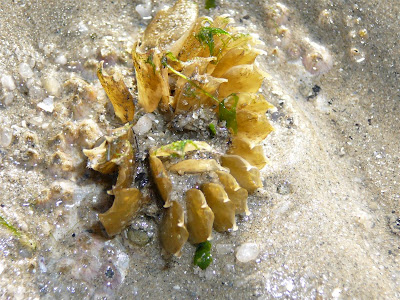
This sunrise made me sleepyhead waking up early worthwhile! Background is Tekong on the left and Pengarang, Johor on the right.
Other than the pretty little button shell (Umbonium vestiarum), can you spot the goby (Istigobius ornatus)?


With the metal chopsticks as a scale, can you imagine how big this Geographic sea hare (Syphonota geographica) is? It swims by flapping the sides of its body.


This tidal hermit crab (Diogenes sp.) is sheltered by a bigger shell and even has an anemone attached on top of the shell. Most likely used to protect itself as the anemone has stinging cells.

Have you eaten a Gong gong (Strombus canarium) before in a seafood dish? Actually they are very cute snails., usually eat algae and detritus. Can you see their eyes. Why cute, see the video below.
These snails hop by stretching out its operculum and foot to the sand and flips itself over especially to avoid "predators" like me.

This is a sea pencil (Cavernularia sp.) Interesting name isn't it? It is because it resembles a pencil...duh. Out of water, their secondary polyps are retracted.

This is not your udon or noodles. Haha.. These pink noodly things are probably eggs of the sea hare, suggested by Ria. Thanks!


Dead Cake sand dollar (Arachnoides placenta), which is smooth without any spines, unlike one that is alive.


Commion Moon snail (Polinices sp.) inflats its body with seawater as it emerges from the shell. What a beauty! They hunt for the tiny button shells as preys.

Sponge (Phlyum Porifera) is an animal though they hardly move.

Sponge (Phlyum Porifera) is an animal though they hardly move.
Striped hermit crab (Clibanarius sp.) likes to shelter in empty shells of dead snails. So dead snail shells are not useless after all.


A Sand star (Astropecten sp.), thanks Ria for correcting my id. Was excited because, yes, my first time seeing a sea star in the shores. Finally right? Sad to see one arm gone. However they can regenerate lost arms but may take one whole year to do so.
Lets see the sea star in action beneath it. It uses these tube feet to walk, handle food and also breathe. How amazing.

Lets see the sea star in action beneath it. It uses these tube feet to walk, handle food and also breathe. How amazing.

The bunches of pink stuff that looks like a carnation are eggs of a muricid snail, suggested by Ria. Thanks once again!
What a beautiful Moon crab (Matuta lunaris)! With their little spades of paddles, they can really disappear into the sand in a second or two. Tested and proven. haha.


Crabs fiesta in Changi. Yes, seriously they are everywhere. One of them is dead, can you guess? Clue: It's not the thunder crab (Myomenippe hardwickii) at the bottom right.
A cowrie shell with a false limpet (Siphonaria sp.) attached on it. The false limpet breathes air through lungs, much like a land snail.
This photo features our fav frog island, Pulau Sekudu!
Our fav lost and found shore, Chek Jawa!! The boardwalks are almost complete, yippee that the public can visit w/o trampling.
Surprised to see more sponges towards the end. Blue and pretty isnt it?
That ends a HOT Monday morning. Thank God cos the sky was clear for a beautiful sunrise! So I am not complaining much when it gets hotter. :P Sunrise more important.
Feels great to be in the shores after camping in library for 3 weeks!
----
Reference: Ria Tan and Alan Yeo (2003), Chek Jawa Guidebook














hi!!
ReplyDeleteI like this new blog that you have set up. Keep up the good work in discovering the wonders of God's creation. =) Look forward to more pics from your natural trips.
kcan
What a fabulous blog! Thank you for sharing these indeed splendid creations!
ReplyDeleteAhem, maybe it's time for you to sign up as a Semakau guide... We usually see a number of seastars during our walks :)
ReplyDeleteThank you An Ni, Ria and Ron.
ReplyDeleteYup Ron! Looking forward to sign up as a Semakau guide, not at the meantime though, till my project dates are confirmed.. am still waiting for the confirmations :)